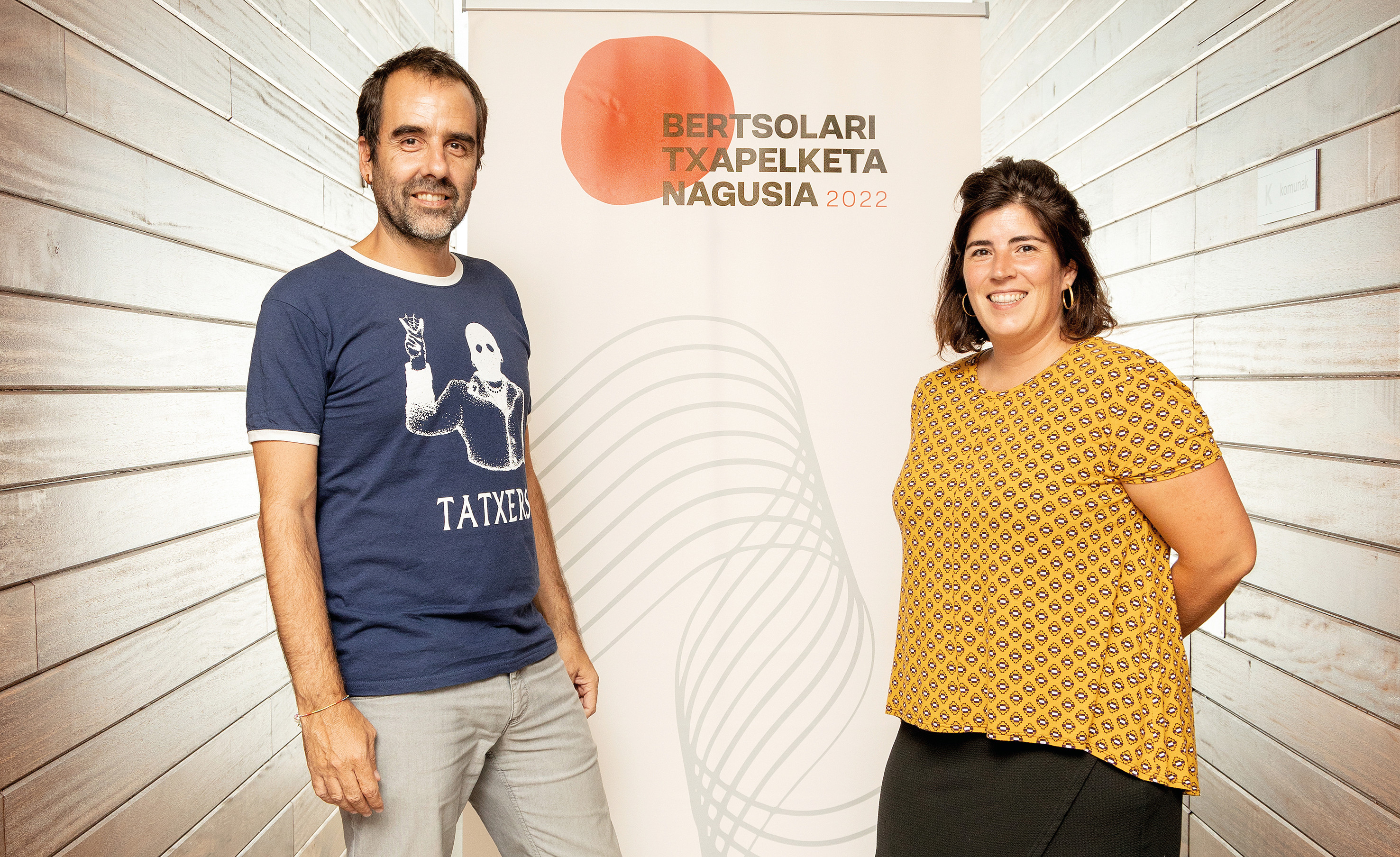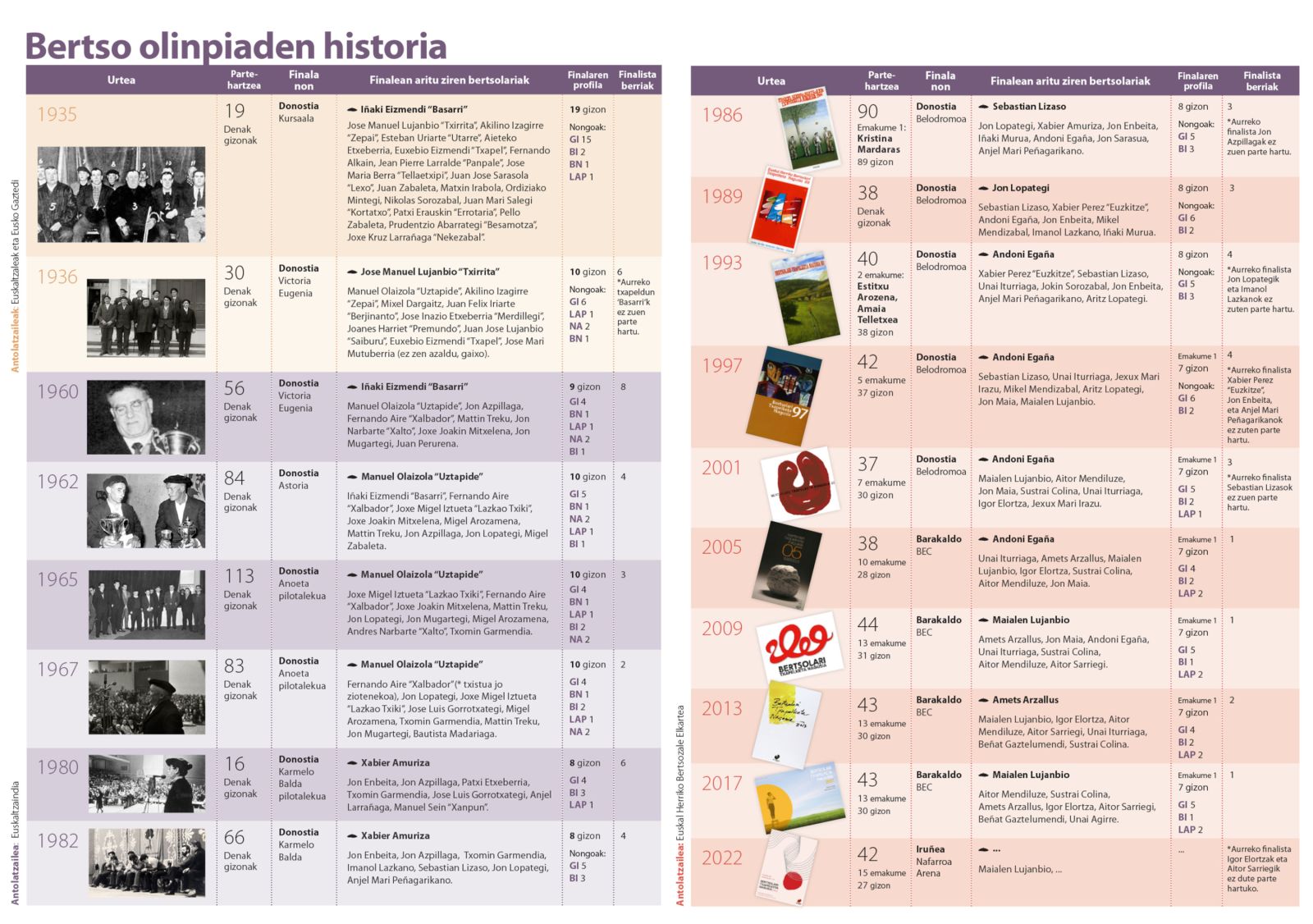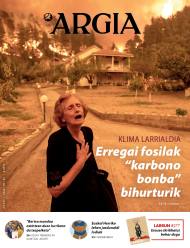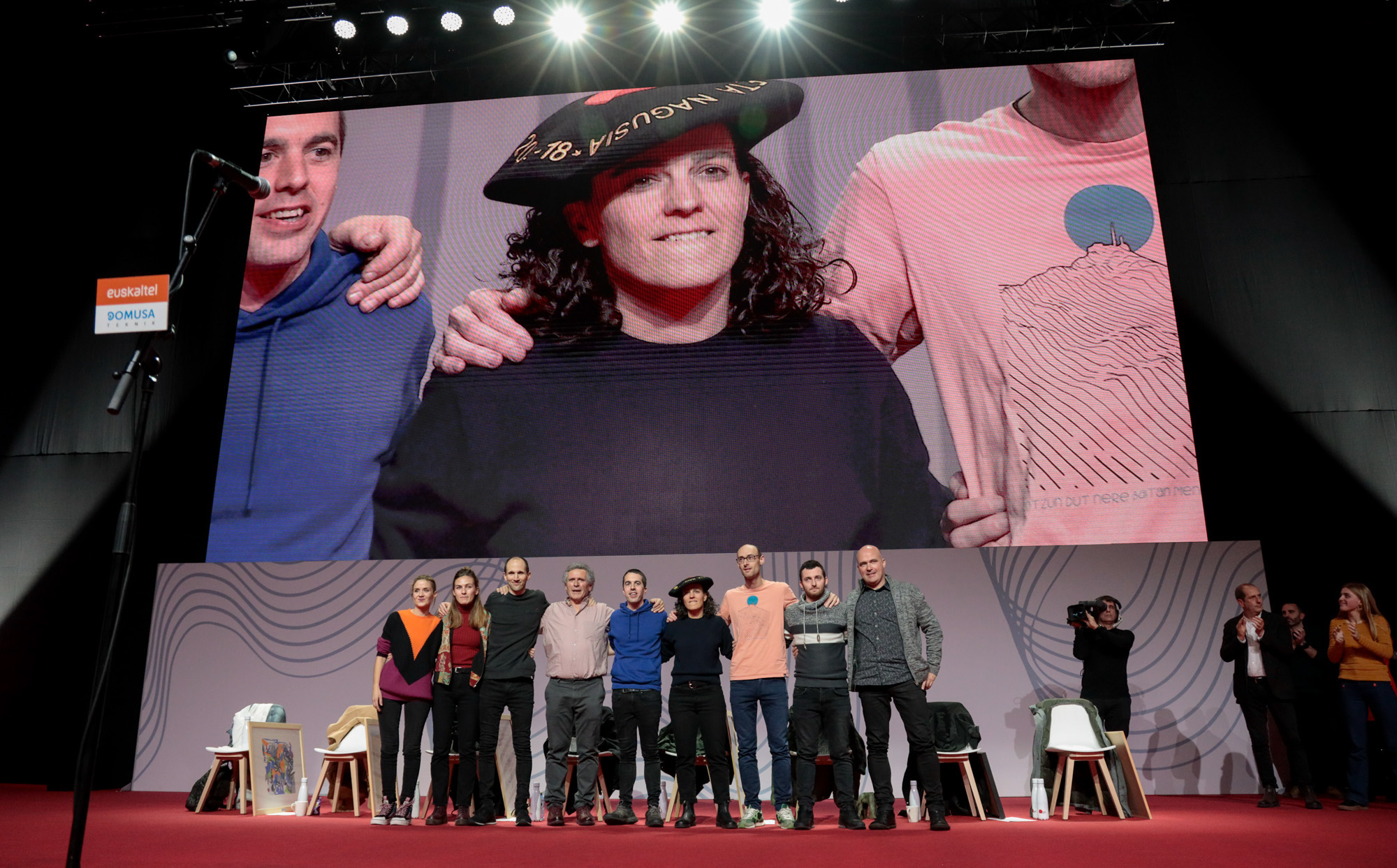“Another small milestone in the development of bertsolarism in Navarra is the celebration of the final”
- On 24 September the Bertsolaris National Championship will start at Getxo, and on 18 December the final will be held for the first time in Pamplona. 41 bertsolaris will take action in the seven territories and await the current champion Maialen Lujanbio in Nafarroa Arena. We asked the coordinator of the Bertsozale Elkartea Association, Idoia Trenor, and Gontzal Agote, of the Promotion Working Group on the characteristics of this year.

What are the characteristics of this year’s championship?
SKIRT: There will be a tournament, and that is something. In fact, the Bertsolaris National Championship is included in the four-year cycle, which has been “normal” in the contemporary era of the championships, but the present is special because that pandemic cycle has not been completed. We came from a very tough time, both the versification and the culture and society, and it's been tough for creators, body builders, Bertsozale Elkartea ... But I think it has also left positive things: we have been able to face a very extreme situation thanks to solidarity, our self-organisation and imagination. And in response to this situation we have brought to light a debate on the role of culture: the working conditions of creators have been talked about for a long time and out loud. This issue now needs a continuation.
IDOIA TRENOR: Yes, it is a championship very contextually marked, because the four-year cycle has turned us into five years. The delay of one year has brought with it greater attention to the social function of bertsolarism and a little more time in organizing the championship for internal work.
G. AGOTE: For those who do not follow Bertsolarism very closely, the Championship is something that falls every four years from the sky. When it was decided last year not to hold the championship, we said that there were no adequate conditions, not only from a health point of view, but because there were no bertsolaris seats. Without bertsos square we can do nothing, the plaza feeds and the championship.
I. TRENOR: When it has become vacant, it has been very significant.
Once the square is empty, are there people thirst for bertso to start the championship?
I. TRENOR: The championship always brings passion, desire, activates more the addict to the verse, is more attentive... From this void of the plaza that has been in Pandemia, we have observed a revitalization of the plaza, a kind of flowering after the void.
G. AGOTE: This resurrection is happening, the summer data is good. A year ago it was unthinkable to be in such a situation today. Things have happened very quickly, in one direction or another. Now, in September, we are in a standardised situation. But we must not forget where we came from. Not only culture, we've all had a bad time and there's a special desire to get things back together, have fun, share...
.jpg)
The final is in Pamplona. Why?
I. TRENOR: It's a touring championship and we work in cycles. We go through the Velodrome, we go through BEC and the cycle change comes. It is not easy to find a place: the rooms that will accommodate so many people are not many in the Basque Country. On the part of creators and from the organizational point of view, this cultural discipline requires its realization in a room or in another infrastructure, not in a football field.
G. AGOTE: It is complicated, yes, by the current dimension of the Grand Tournament Finals, both by the number of people and by being a full-day event. To this must be added the displacement of buses, food, which is celebrated in December... All this must allow the place chosen.
I have been working for many years in the Navarra Association of Bertsolarism Fans and from there I have seen the evolution of bertsolaris production in Navarra. Another small milestone in the development of versification and bertsolarism in Navarra is the celebration of the final. Moreover, a few years ago it was unthinkable to do so in Navarre, among other things because it was not possible to maintain a normalized relationship with local institutions, but the denial was the main one. Now the relationship is not ideal, but some things have changed, we have more facilities and more recognition: a few years ago the Government of Navarra declared bertsolarism as the intangible cultural heritage of the place. And our current relationship with Euskarabidea was unthinkable a few years ago. We are aware, both from the cultural and symbolic point of view, and from the territorial and Basque point of view, of what it is to bring the end to Navarra. All these factors have led us to Pamplona.
Should the public institutions of the territory where the final is held face the challenge economically?
I. TRENOR: I would not say that it is completely disconnected, but that is no reason for decision. The decision, as Gontzal explained, is related to the development and context of Bertsolaris. The Association has a wide range of sponsors without which it would be very difficult to conduct the championship. In recent years the Association has done a great deal of work with the institutional relations it has to support the Association project as a whole, and not just the championship. The championship is what society sees most, but every day there are bertsolaris schools, the Xenpelar Documentation Center -- what the Association needs is to support that daily work. We started to give new meaning to our collaboration with the institutions, and from there we built relationships. But there are also direct sponsors of the tournament, be it the deputies and the Government of Navarra.
G. AGOTE: The change occurred since the previous championship, with the objective that the sponsors would not be linked to the championship. Although we know that the tournament is very tempting, even for commercial brands. Some reproach us that we do not commercially dream the championship. But we organize it based on values.
Returning to the subject of the final, the Association decided that the final was to be held in Pamplona and subsequently communicated to the Government of Navarra to initiate organisational relations. Sponsorship was not a condition, the championship is not an auction.

Did the move from Donostia to BEC drive away some ghosts? The doubts of that time were that most listeners were Gipuzkoans and perhaps they would not move, if BEC would be fulfilled...
I. TRENOR: I didn’t come into the Society at that time, but from what I’ve received I already know that it created a great stone and that it was a great challenge. In BEC, at that time it was a strange environment for the verse. Then it has been seen that no, the end has managed to be for the public an event that cannot be missed: people want to be there and bertsolari is willing to move where the end is. When I moved to Pamplona I did not notice any fear.
G. AGOTE: On the contrary, it has created joy. The next step at BEC is San Mamés. Although we try to work our way and do not get too far from it, with the championships we get contradictions: we live in the society of the show and people want bigger, faster, more... The championship has a travelling character, but we try not to uproot: in the localities where the championships will be held it is made pre-elaboration, it is attempted to leave a mark...
The championship has significant organizational expenses. How is it funded?
I. TRENOR: It has different sources of funding: on the one hand, the sponsors mentioned. Another important part is advertisers, as a great deal of work is previously done to unite advertising. In this area there are also advertisers who focus only on the tournament, but others who advertise more initiatives of the Association. The Bertsozale Elkartea Association has about 2,500 members, whose quotas also support the tournament, and of course the sale of tickets is the other essential source.
.jpg)
To what extent do the economic results of the championship maintain the Bertsozale Elkartea project?
I. TRENOR: The championship has been held in four-year cycles and the Bertsozale Association operates with a four-year financial plan. The budget of the association is in principle deficient, but in a cycle of four or almost five years, that is, until the next competition, the championship gives it the basis to deal with this deficit. The economic situation has changed, the Association’s expenses have also increased, the deficit has increased and we are turning the financial cycle or model. The one-year delay in the competition has had an economic impact for the Association, but it has not done so entirely because the Association has many years of history and the economic base of the years was there.
G. AGOTE: Some of the projects carried out by the association could not be carried out without the income of the championship.
The economic results of the championship are also the result of volunteering. How many volunteers compete in the championship?
I. TRENOR: When deciding the locality in which the championship sessions are organized, we take into account the bertsos movement in that country, the relations we maintain... the championship also reinforces the network of bertsos of local and regional scope. From this network comes many volunteers.
G. AGOTE: When we say that the championship will be held in the seven territories, it is a reflection of reality: in some territories Bertsolaris is stronger and in others less, but if we are in the seven territories. If we decide to do one session at Estella and another at Gotaine-Irabarne, it's for something, because in those places there's a group at the base.
I. TRENOR: From the point of view of the types of work, in the championship there are technical, strategic, internal, external works... in all these types of work and in the decision centers. That's the richest thing. Without that mass of people who work voluntarily, it would not be possible to organize the championship.
G. AGOTE: The activity of the association is also so, many of the works carried out with the protection and participation of volunteers. The Championship is a reflection of the Association’s work each year.
In the National Championship each territory has a different number of representatives. All the finalists of the last edition have the opportunity to participate, besides 2 bertsolaris from Álava, 10 from Bizkaia, 16 from Gipuzkoa, 5 from Navarra and 3 from Iparralde. Has there been any evolution in those proportions? Do you intend to change the future?
I. TRENOR: Since the association took over the organization of the championship, Bertsolarism has evolved very significantly and has acquired a great dimension in each territory. The figures established in 1986 and in all these years have been forwarded for discussion to the Association's management on several occasions and have been amended. Now it is also time to rethink it: once the final is contested, it will be time to look at the general championship, and within it we want to review whether the quota set for each territory is adequate or needs to be changed.
G. AGOTE: I remember the last change, Navarra was the fifth representative. We try to make the championship a picture of Bertsolaris today, but it's not a math question. In addition, the Association has strategies and decisions based on them.
.jpg)
In view of the photograph of the arbitral team, I found it to be multitudinous, under 50 years old and quite egalitarian in gender. How has that team become?
G. AGOTE: There's a lot of work that you don't see behind the arbitrary team. Along with those who are judging, there are substitute judges, there are judges who are calibrating the scores... on that progress has been made, ten years ago the arbitral team of the Basque Country was expressly activated for the tournament. The effort made in recent years has been the continuous training and active maintenance of the equipment. We have also tried to strengthen the group and to be more plural.
I. TRENOR: The work of the judges is very individual and it was necessary to strengthen the team character to support and contrast: discussing criteria, sharing references... and on that the Association has worked. In each country there are groups of judges, but it has been enriching to share with other groups of judges in the Basque Country.
G. AGOTE: The work of rapporteurs and judges must also be recognised.
I. TRENOR: The work of these two groups is invisible and highly criticized.

How is the group of rapporteurs formed and working?
I. TRENOR: In each territory there is a group of topic rapporteurs focusing on the country championship. To form a group of Basque rapporteurs, the group in each country chooses between two and three people. In this group they have a very intense dynamic: all the members meet and spend hours going around and around the issues.
How and when are the types of work that bertsolaris will do? Are there any changes to this this year?
I. TRENOR: The tournament’s organizing team is divided into three working groups: communication, infrastructure and the new bertsolarism team created this year. The bertsolaris group has been composed of judges, Gaiters, Bertsolaris and Bertsolaris fans who will not participate in this tournament, along with the head of the Association Development and one of the coordinators. And one of the works that this group has done is to analyze and regulate the types of exercises.
G. AGOTE: Changes in the championship exercises are very difficult. Some consider that the championship has to be an experimentation space, but others say that the place to experiment is the plaza or that there are other areas and that the tournament has its own rules. It is difficult to change the exercise a lot and it needs a lot of consensus.
I. TRENOR: The types of exercises have not changed, but the determination to put them to the group of rapporteurs has been the courage of the bertsolaris group. For example, if bertsolari A has to “oppose” bertsolari B, if it has to “put together” A and B, or if both have to face a situation… so far the bidders also had to decide, “against A B” put it in the big zortziko or in the decimal… In those discussions it’s a long time. This year it was agreed in the bertsolaris group and it was possible to focus on the content.
The Bertsolarism group has transformed “prison” into “chamber”. Why rename?
I. TRENOR: For the bertsolaris themselves this situation is hard to call “prison.” The name didn't calm that moment and we wanted to give another meaning. Among a lot of names, the “chamber” has been chosen, because the “chamber” is not only a space, but is also used to express the “head”, a situation in which the bertsolaris give a thousand laps in the head and it is a moment of concentration, of being the bertsolari inside, with its camera.
On the other hand, during the championship, the bertsolaris group will carry out an observation work and will serve as a refuge for both rapporteurs, judges and bertsolaris.
You mentioned the role of refuge. The tournament has to appear in public and thousands of listeners become judges. This stretch of strong foci is a very demanding catwalk for bertsolaris, butchers and judges...
I. TRENOR: Yes, the exposure is very high. That is why the group character, both the rapporteur and the judge as a group, is important, as their support is necessary to maintain the incidents, to leave with force... Because only when the time comes will the instructor be on stage, or only the judge will judge the verses. Both proponents and judges are part of the Association’s project and have our support. This is the team of judges of this tournament, chosen by the Association, who are the people who will decide, although the decision does not like some listeners. Competition rules are as follows.
G. AGOTE: It's an earthquake that affects the entire verses movement. Criticism must be made, but constructively. In competition they are usually moments of tension and our job is to channel them and after competition analyze what has been done well and what has failed.
I. TRENOR: In the championship we all get the judge inside. “I like it or I don’t like it,” or “it’s been right about it or it hasn’t invented it.” The first comments were in the session room or in the post-session boat, but since the social networks are underway, comments become viral. A spontaneous cultural activity is judged in 140 characters, and that decontextualized phrase goes a long way.

The tournament will bring together some 14,000 attendees. It's a lot, but they don't fall from the sky. Around 36,500 listeners have gathered in the squares in the first half of 2022.
I. TRENOR: On the part of the public, I don't know how much it reflects the square.
G. AGOTE: There are many listeners who only attend the tournament every four years, one of its virtues.
I. TRENOR: And there are many others who won't go to the end. There are also people who are not attracted to competition.
G. AGOTE: Many people who go to the end are surprised by this number of people, especially those who are far from Basque culture. The end is not something that comes from nothing. It is a fact, they look at us enviously in some parts of the world and all of this we must take advantage of to enrich our base. Some of those who only go to the end will take pride, perhaps some child will want to go to the bertso eskola ...
I. TRENOR: The final is beautiful, but all the tests of the championship are to enjoy. The semi-finals will also have a large number of participants, between 1,500-3,000.
.jpg)
If it is curious that more women will be incorporated in the end. In the plaza parity is not far away: According to the association, in 2022, 53% of the seatings were men and 47% women...
I. TRENOR: I believe that the increase in the number of women in the evolution of the square is not a single reason. The association does not organize places, but various organizers, but among them there is a conscience. It may be that gradually more women compete in the plaza and are completing a longer journey. And on the other hand, after the pandemic, it took some time until the implementation of some types of berts, in which participation is the most unequal: those of food and those of free. The sessions that began were festivals or special sessions in which the participation of women is more balanced. Now, when friends and free programs have gone to normal, the other types of sessions have not gone down. That is why the data say that participation is fairly balanced, but much remains to be done.
The association is putting resources into promoting parity: it has three transversal lines, including feminism. The implementation of these cross-cutting lines in all projects has its consequences and perhaps we have started to see them. Another thing is what expectations each one places at the end of the tournament.
The octet of the final can also be analyzed from the territorial point of view. Does the fact that the locals reach the end influence the countries?
I. TRENOR: For me, once the country championships are over, when the General Championship begins, they are bertsolaris of the Basque Country.
G. AGOTE: These changes are slower than desired. The development that is taking place in Araba and Iparralde cannot be seen from one year to the other in the final of Euskal Herria, also considering that the photo of the final is very similar in the last three championships.
From Navarra, I have noticed that the triumph of Saioa Alkaiza has influenced that she is a woman, young and from the Region of Pamplona, as his daughter of model D... Many people have been identified, especially in the erdaldun environment. He has become a reference and is important. But with the final of the main championship there is a special theme and the main championship is a monster, very difficult to move. The results of the work we are doing will come, but perhaps not immediately.
I. TRENOR: Changes in country championships are easier to detect.
G. AGOTE: And it's logical to think that that's going to come to the General Championship, but maybe not at the speed we would like. We want to transform things: on the one hand we know where Bertsolaris is rooted, but on the other hand we are gaining new fields.

OLDER AND YOUNGER FINALISTS
The oldest bertsolari in championship history is Txirrita (who was 76 when the txapela was introduced in 1936) and the youngest are Unai Iturriaga (at the end of 1993) and Subai Colina (at the end of 2001).
This year’s youngest bertsolari is Gorka Pagonabarra (22 years this year) and the oldest Unai Agirre and Aitor Mendiluze (47 years this year). The average age of the bertsolaris in this championship is 34 years, as in 2017, and is the oldest average of the last 20 years: In 2001 the average age was 27 years and has since been growing (in 2005 the average was 28 years, in 2009 30, in 3013 of 33).





















